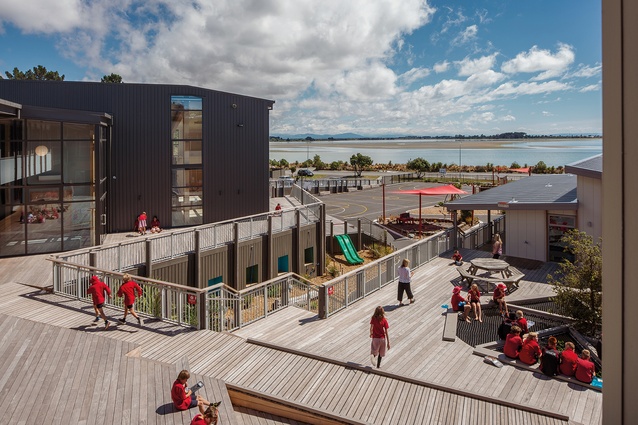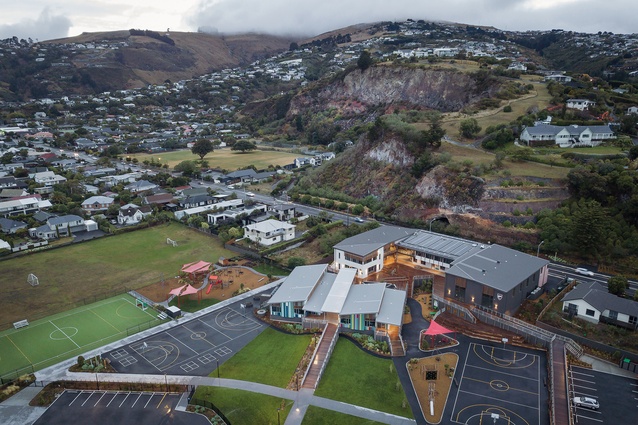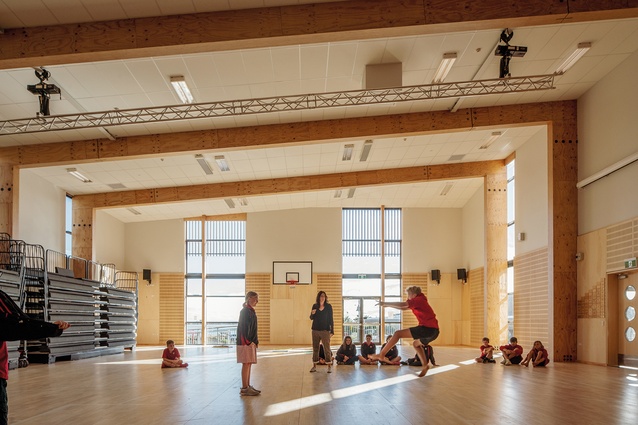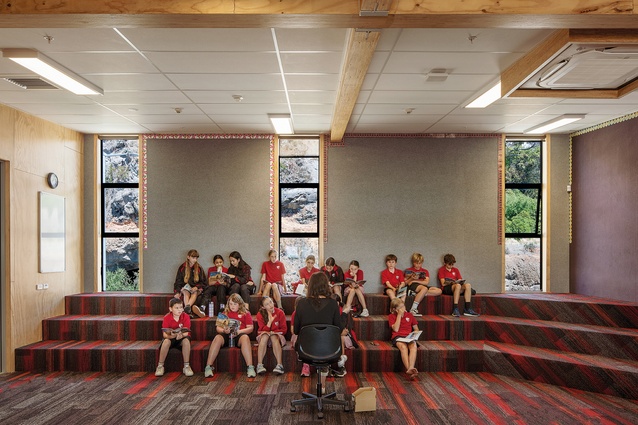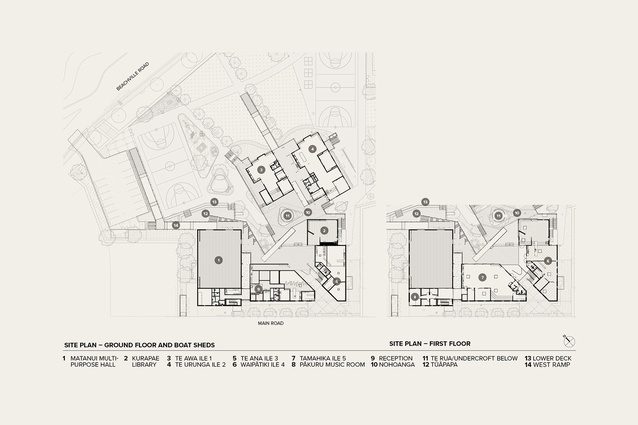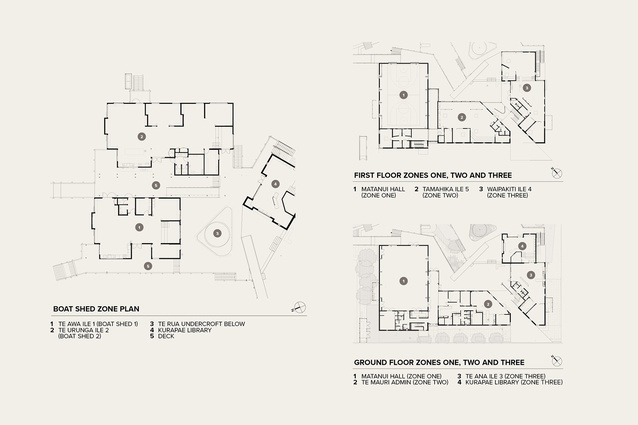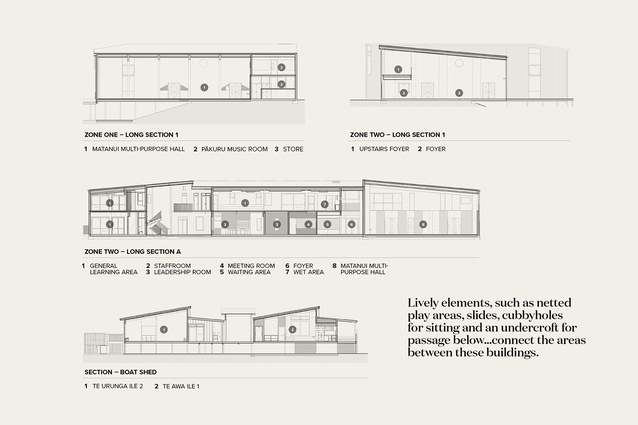Bringing the community and culture in
Abigail Hurst talks to Tennent Brown Architects about the difficult site, the cultural narratives and a new take on innovative learning environments in the design of Te Raekura Redcliffs School.
Rockfall risk from the cliffs behind meant Te Raekura Redcliffs School was left without a home when its site was deemed uninhabitable after the Canterbury earthquakes. After the school spent seven years fighting the Ministry of Education and resisting its closure, a land swap with Christchurch City Council was agreed in 2017. Redcliffs Park, across the road from the original school site and facing the water’s edge, was to become the school’s new home: a unique opportunity for the small seaside community to design its school from scratch on a remarkable piece of land.
The new site has a rich cultural history as well as complex geographical challenges, including a flood hazard zone and geotechnical issues. Between the escarpment along the road from the Raekura Redcliffs and the Heathcote and Avon Rivers estuary, Ihutai, the land drops significantly, resulting in a flood plain level of 1.8m above natural ground for much of the site. The school brief, and Ministry of Education (MoE) and planning requirements, the latter generated from building a school in a residential zone, created a tricky set of parameters.
Wellington-based practice Tennent Brown Architects dealt with the vertical nature ofthe terrain by resolving the large amount of required indoor area within a bold two-storey building, perched on the high edge of the site near the road. Three of the seven ‘innovative learning environments’ (ILEs) are contained within this volume, with the remaining four stretching towards the sea as ‘boat shed’ type structures. Lively elements, such as netted play areas, slides, cubbyholes for sitting and an undercroft for passage below, have been cleverly designed to connect the areas between these buildings. Consequently, there is a graceful flow between inside and out, with a united orientation towards the view of the estuary, making navigation of the school both easy and delightful.
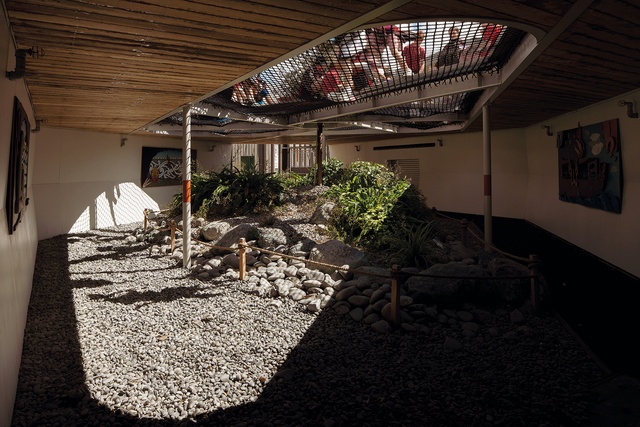
Against the front edge, the main administration and entrance have been grouped logically with the hall and foyer, the school kitchen opening to the main circulation space and staff offices. A learning coach runs a café from the kitchen, training students to serve their peers and parents. Access to coffee through this ‘hole in the wall’ has created an informal meeting place for adults passing through, the double-height ceiling giving a civic quality to the space, despite its small size. Assisting with the generous spatial quality is its relationship to the outdoors; carefully planned fenestrations draw the eye to the view of the water. Round, portal-style windows above set a playful tone and provide a nautical nod. This is a space that integrates the school with the community by inviting passers-through to spend time in it.
A void has been cut through the school’s main two-storey volume, creating a pedestrian tunnel and view back to Raekura Redcliffs and Te Ana o Hineraki (Moa Bone Point Cave) within the cliffs opposite. It is a place of both historical and cultural importance, having been used intermittently by Māori as a shelter and place of food preparation as early as the 14th century. It was excavated in 1872, and moa bones and eggshells were found on the floor, providing insight into Māori occupation of the area.
The tunnel creates a physical pathway as well as a symbolic one: linking the sea to the cave and referencing the journey Ngāti Māmoe once made, bringing kai from their boats to this shelter in the rock. The tunnel punctuates the volume of the main building from the road, providing a glimpse into the otherwise visually and physically protected school grounds. At over 8m high, this outer perimeter appears quite an abrupt vertical face for its residential setting. However, the terracotta pre-cast- concrete panels of the wall, referencing the colour of the cliffs opposite, assist in fitting the school buildings within their context. This is a building that says: “Here we stand, and here we are meant to be”.
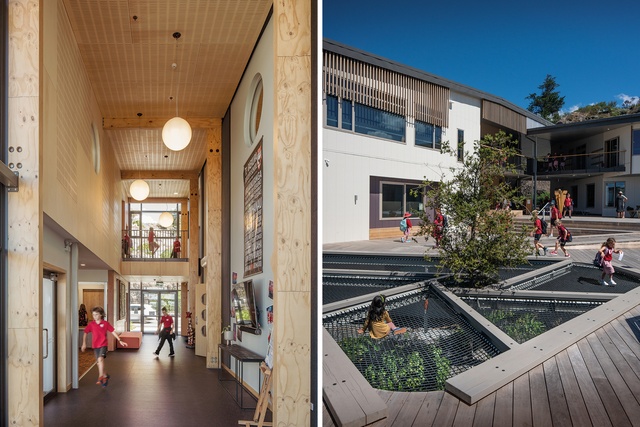
The site’s strong cultural narrative and history formed the conceptual basis for the design of the buildings from the outset, though more-formal collaboration with Janina Konia, Mana Whenua Education Facilitator of Mātauraka Mahaanui, did not take place until later in the design. While this engagement could have happened earlier, Mātauraka Mahaanui was able to work with the designed framework to assist and improve the recognition of mana whenua values, hugely enriching the project. Each ILE space was bestowed a name by mana whenua iwi relating to a physical feature of the site and this identity informed interior design decisions. Each group of students is told the story behind the name of its room, relating to a physical aspect of the site. This enables students to sense their part in a greater narrative about the school and the land on which they stand.
The architects also planned locations for two additional ILE spaces when needed for roll growth – the current school roll is 240, with a maximum capacity of 400 students. With a mind towards caring for the future, sustainable design initiatives, such as natural ventilation and a photovoltaic array, were included. Interior materials such as carpets and wall linings were selected with longevity and sustainability credentials in mind. In the main hall, a real boon for the school, which is passionate about performing arts, LVL portal frames are featured, their legs transecting the windows. These junctions look slightly odd at first but do allow light to play across the timber, highlighting the warmth and value the frames add. Along with LVL frames in the hall and foyer space, low-carbon timber has been used throughout the buildings where budget restraints allowed, minimising the school’s carbon footprint.

Architect Hugh Tennent says Te Raekura Redcliffs School was clear about the vision and values its new buildings should embody and was also keen on experimenting with ILE teaching styles, knowing MoE would require this change from the previous single-cell style of learning. Largely driven by principal Rose McInerney, the school had consulted with the students and parents about what worked for them. Rather than three teachers overseeing 90-odd students in one open area as is typical of ILEs, the strategy adopted was a clustering of mainly two cohorts — meaning teachers work in teams of two in each of the MoE-required ILE spaces. The teachers and architects knew from experience that a sufficient number of break-out spaces would be needed to manage the acoustics and visual distractions present in large open-plan areas. Pockets of indoor and outdoor space to facilitate this teaching strategy have been craftily interwoven through tucks in the plan and half-height level changes, with teaching expected to occur outside at times. This allows teachers to collaborate but, also, teach smaller groups of students as needed.
These nuanced ILEs are also shaped to suit each year level, with the new entrant class and Years 1 and 2 tucked in the core of the main building, their spaces designed to create a cosy, nested feel. Two smaller rooms for more structured learning can be closed and opened to the larger space, with easy lines of sight across low-level spatial dividers providing the level of support needed at this young age. Years 3–6 are set in the elevated ‘boat sheds’ facing the water, where the increased amount of independence and ownership children have over their learning is recognised in the configuration of the break-out rooms. Learners can be grouped according to needs and a wide range of teaching styles utilised — the architecture supporting the advantages of pedagogies that ILEs are intended to facilitate.
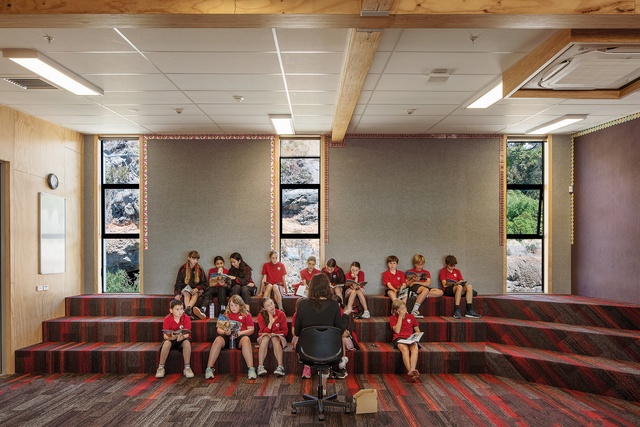
This includes inquiry-based learning, increasing in the older year-group cohorts — with a wider variety of workstations available for cooking, science and art. The ILE for Years 7–8 on the second floor of the main building gives children the agency to personalise their timetables and use different spaces more freely – arguably increasing their motivation to learn. These differences also make each room feel unique, a sense of progression given in each child’s journey through the school years. Although the school has since included additional pull-back dividers to two ILEs to manage the noise and distraction prevalent in open-plan spaces, the teachers agree the architecture assists their current teaching strategy.
Architecture doesn’t just play a background role at Te Raekura Redcliffs School, it is influential in bolstering the teachers to educate effectively and highlights the significance of the site and its cultural narrative to those who teach and learn in it. This is a story of triumph after a disaster: a small seaside school and community who have made a strong stand and worked to achieve a school that supports their tailored teaching style, reflecting who they are and the land they now occupy. Te Raekura Redcliffs is a school that is a home for this generation.

